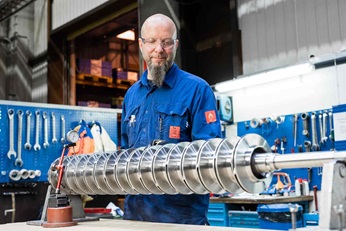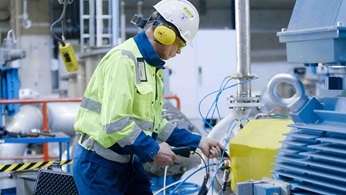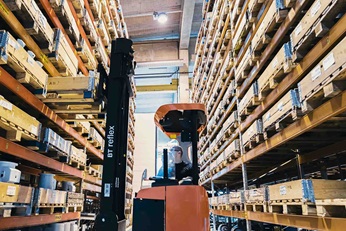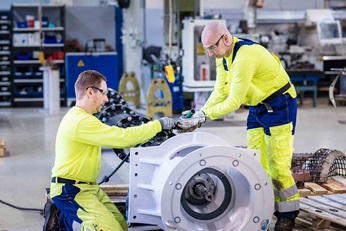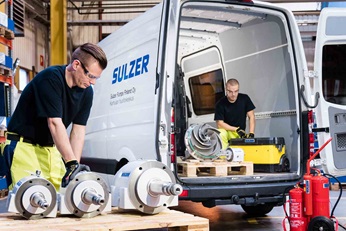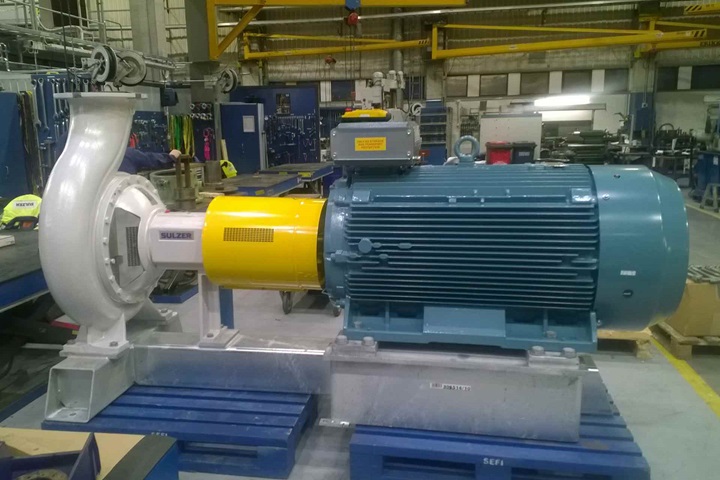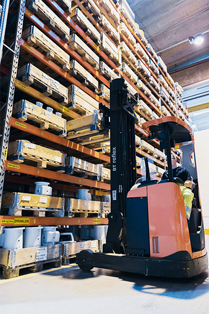Technical article
Invest in the entire life cycle of process equipment
Sulzer specializes in pumping, agitation, mixing, separation, and purification technologies for fluids of all types. The manufacturing process of pumps, mixers, and compressors until commissioning only accounts for a fraction of the life cycle of the equipment. When looking at the cost of the equipment over its entire lifetime, it is possible to achieve considerable savings through optimization.
Efficient and optimized equipment selection is the starting point. After that, the costs can be minimized with services at different stages of the equipment life cycle. Sulzer not only delivers the equipment but also supports the customer throughout the entire equipment lifetime, from selection and maintenance to recycling. There may also be situations where the problems that occur in the equipment are not caused by the device itself, but by the process, for example. Also in these situations, we support the customer on site and solve the challenges together.
The customer matters – also when it comes to the environment
When the equipment has come to the end of its life cycle, Sulzer by no means leaves the customer after decommissioning, but we support with recycling and reusing. When possible, we reuse operational devices instead of turning them into scrap. There is a high demand for such pre-owned equipment.
In the hands of a professional team, even very old equipment can be refurbished to serve the needs of another customer. Faulty equipment is disassembled and examined, and usable parts are utilized. The customer always receives a device that is functionally equivalent to a new one, and refurbished parts are openly communicated.
Sometimes there is material that cannot be reused. Pumps include components made of different materials, such as bearings with plastic holders, cast iron parts and acidic materials. These items are sorted carefully and, as a result, processing them further is easy.
Sulzer’s advanced recycling process has a positive impact on the environment. We also focus on the carbon footprint and energy efficency. Environmental matters are stressed in the company’s strategy, and they are implemented in the goals of each employee. As a large operator, we have been able to develop high operating standards. We strive to be an exemplary supplier and to meet the customer’s requirements. Our customers also need to reduce their emissions, carbon footprint and energy consumption, and we strive to support them in this. Accordingly, we have received good feedback in this area in recent supplier evaluations.
Trust and openness at the center of maintenance
While the equipment is still in operation, its utilization rate can be improved with the help of various maintenance services. Sulzer’s goal is to enable the customers’ processes to function without disruptions and unplanned stops.
We tailor service contracts for different needs. Maintenance services can include, for example, measurements and analysis that take place at certain intervals, storage services, or services related to the equipment as a whole, such as exchange unit services or even storage services for the entire equipment. With these services, the customers can optimize their own inventory. Equipment testing and test drives can be performed either in the customer’s facilities or in Sulzer’s own test drive stations.
With a maintenance contract, Sulzer can take care of the inspection of the entire installed base, whereby the equipment is inspected at agreed intervals. We report the result to the client, who basically does not have to do anything else than accept the measures we may propose. Test drives to assess the equipment and its performance can be performed regularly if the customer so wishes.
When it comes to maintenance services, trust and transparency are key factors. For example, failure frequencies are actively examined to reduce the customer’s maintenance budget. Sometimes devices fail too often due to process-related reasons. If the interval of device failure is too short, we will raise the issue. Together with the customer, we try to find out what the problem could be. Problem areas can be eliminated by modifying the process, and the utilization rate can be improved.
Optimized inventory frees up capital
With our storage services, we aim to minimize or even eliminate the customer’s equipment inventories and the capital tied up in them. In this service model, Sulzer commits itself to the delivery of certain parts and equipment at a certain time. The deliveries respond to the actual need, and the customer will not have extra parts on the shelf.
In addition to saving storage space, the parts are always up-to-date, even if changes are made to the equipment base. If the device has been changed, for example, in connection with updating the process, the customer may be left with parts that cannot be used. When the parts are included in our storage service, they can be modified to fit the actual situation and there will be no wasted material, storage, or capital at any point.
The optimization of spare parts should be planned together with Sulzer’s personnel, because they have long experience of different customer needs and demanding processes. For special materials, delivery times must also be taken into account. By prioritizing the devices into different categories, it is possible to optimize the different operations and related spare part investments.
Sulzer emphasizes up-to-date spare parts and documentation for the installed equipment base. It is in everyone’s interest that the supplier is aware of the changes made to the customer’s equipment, so that the customer can be served as effectively as possible. This way we can provide the right parts at the right time and to the right place – and reduce waste. When maintaining and updating the documentation is outsourced to the supplier, the customer always has a correct and up-to-date equipment register and configuration.
Prevention at the heart of maintenance
In terms of maintenance, Sulzer focuses on preventive actions. For example, our aim is to be involved in the planning of downtimes at an early stage. This reduces the customer’s workload. Equipment maintenance and even work management can be organized by Sulzer, and the measures can be optimized according to the length of the downtime.
Maintenance measures should be carried out not only during downtimes but also when the equipment is running. Accordingly, thorough advance maintenance instructions are planned together with the customer to extend the life cycle of the device. Pre-maintenance measures can be carried out independently or they can be outsourced to Sulzer, who can organize measuring, analysis, and inspection on behalf of the customer. As a rule, the actions are taken on-site, but if the devices are equipped with measuring equipment, the inspection can also be carried out remotely. This is an area where Sulzer is expanding.
Corrective maintenance on site and in service centers
Sulzer carries out corrective maintenance both at the customer’s site and in its own service centers. On-site maintenance is suitable for small daily downtimes, emergency maintenance and unplanned situations. We are on standby around the clock and can travel to customer locations at any time, and can carry out small-scale repairs, renovations, inspections, analyses, and measurements at the customer’s site.
More extensive repairs are mostly carried out at Sulzer’s service centers. Transporting the device from the customer’s premises requires time and planning, but the advantages are considerable. What is unique is that after servicing, almost all devices are test driven before they are delivered back to the customer. We have several test loops that can be used to verify the required performance of the device. Corrective maintenance at the service center is a very safe option for the customer.
For a safe start-up of a process line, verifying the condition of the equipment is very important. It can even avoid problems and downtimes related to the start-up. The cost of corrective maintenance carried out at the service center is only a fraction of what a possible second downtime would cost. It ensures a safe start-up and normal production for the customer’s production line.
